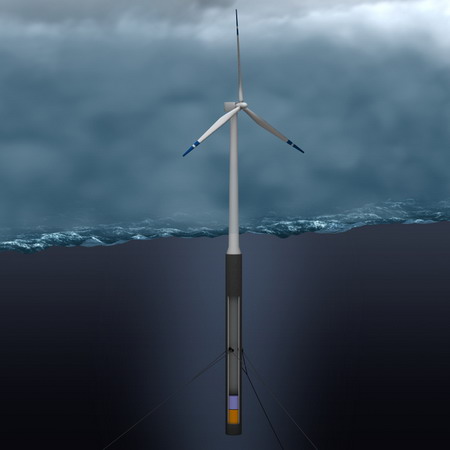Five Gigawatts in the Gulf of Maine
 A concept drawing of a floating wind turbine, using technology from floating oil-drilling rigs. From StatoilHydro.
A concept drawing of a floating wind turbine, using technology from floating oil-drilling rigs. From StatoilHydro.Midcoast Maine is becoming more and more like a Houston country club: every summer, more retired Texan oil millionaires arrive to fly the Lone Star flag from their waterfront summer homes. But one of those millionaires, Matthew Simmons, of Simmons & Company International, has taken his retirement from the fossil-fuel industry to an unusual extreme.
In the past year, Simmons has become the "prophet of peak oil," citing his extensive geological knowledge to argue that the world's supply of oil can't keep up with demand, and has predicted middle-term oil prices to rise as high as $300 a barrel (the recession, of course, has evened the balance between consumption and production for the time being). Here's a clip of him on CNBC last year.
Simmons is very concerned that the existing economy can't sustain itself with dwindling supplies of oil. So he started the Ocean Energy Institute, a nonprofit based in Rockland that's dedicated to finding alternative energy sources derived from the oceans. Maine could become to renewable energy what his old hometown of Houston was to oil.
The Institute has quietly floated a plan to build a 5 gigawatt complex of floating wind turbines far offshore in the Gulf of Maine. As proposed, the project could produce more electricity in steady winds than all of the state's existing power plants combined. Even more power is possible, but the 5 gigawatt scale was chosen because that's how much electricity it would take to replace oil as a source of winter heat in Maine's buildings.
At this point, it seems more like a thought experiment than a serious proposal: the $25 billion price tag is more than double the amount of T. Boone Pickens's monumental wind farm in the Texas panhandle. But unlike Pickens's project on the prairie, this one would be a lot closer to the cities where electricity is consumed, which means that its transmission costs could be significantly lower.
So if the economy does recover and oil shoots back up to $300 a barrel - in three to five years, say - I could see this moving forward. With it would come a huge mobilization of workers in Maine's shipyards, the likes of which haven't been seen since World War Two. Imagine the work required to install two thousand wind turbines onto floating platforms, ship them out to sea, connect them to the grid, and keep them in good working condition.
In the past half century, Maine's industries have mostly turned their backs to the sea, and our state's shipbuilding tradition has mostly relied on largesse from the military. We've also gone from heating our homes with wood we grew in our own forests, to heating them with oil from God knows where. Maybe 21st-century wind power technology will restore Maine's traditions of self-reliance, and hard work on the high seas.




2 comments:
Good. If they're careful.
Remember there's no free lunch.
The five gigawatts of energy captured by the windmills and removed from the air is five gigawatts of energy no longer transferring to the surface of the sea.
Five gigawatts may not of itself significantly change, but together with windfarms off southern New england and elsewhere, there may be a cumulative effect.
As the wind energy removal from the sea surface cannot be having no effect at all on the system it is being removed from, the challenge is to discover what is being effected and how much it matters.
Really nice post. Thanks for this informative post.
Post a Comment